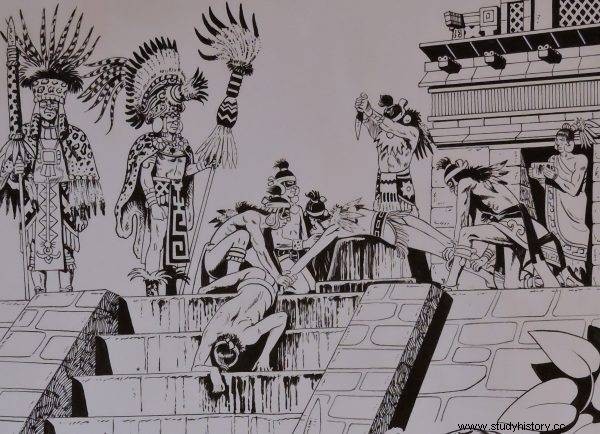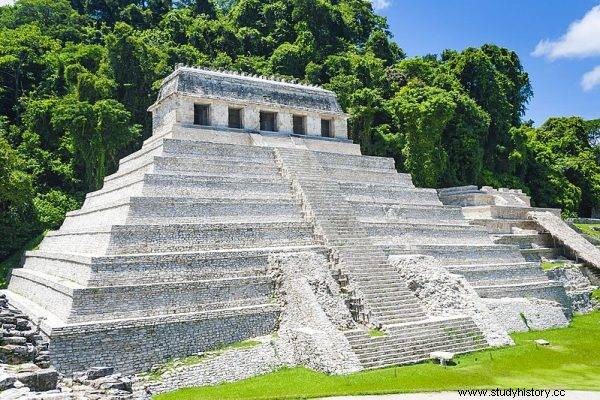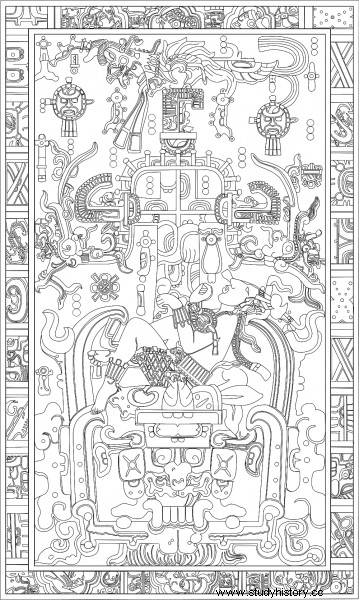They worshiped the gods so zealously that they did not hesitate to make human sacrifices. They hid their rulers inside monumental buildings. What secrets do the Mayan tombs hide?
In 2020, the secrets related to the funeral tradition of the Indians were put on the wallpaper by researchers from the Japanese archaeological team, which in order to X-ray the interior of the Mayan royal tomb dating back to 1.2 thousand. years he used the most modern methods. It is about the so-called muon radiography - a revolutionary technique that uses muons created in the atmosphere by cosmic rays.
Journey to the other side
In contrast to the culture of ancient Egypt, where the funeral ritual was of great importance, and all mortal life was treated as a preparation for death and transition to the other world, in the case of the Maya this thread seems to remain on the sidelines of issues related to their civilization and culture. Emphasis is placed on stunning construction, scientific achievements, and astronomical knowledge. So how did the Maya "depart"? We know relatively little about the burials of ordinary people. They didn't stand out with anything special. The Mayans often buried the dead under the threshing floor of their homes. These were skeleton graves. The corpse was wrapped in linen, grain was put into the mouth of the deceased. Everyday items that could be useful to the deceased in the afterlife were placed in the grave.

The Maya worshiped the gods so zealously that they did not hesitate to make human sacrifices.
Of course, the rulers were bid farewell differently. The kings of individual city-states often - like their Egyptian counterparts - built tombs for themselves while they were still alive . After their death, they were buried there with stunning treasures. The Mayan equivalent of Tutankhamen's tomb, a funeral treasure preserved in good condition, may be the burial in Palenque - one of the largest and strongest Mayan city-states in the classical period. In the 7th century AD the city was ruled by King K'inich Janaab 'Pakal. He sat on the throne at the age of only 12, after a series of devastating wars. However, he managed to stabilize the situation, rebuild the city and erect many new buildings. In his day, Palenque was at its peak. Pakal ordered a tomb to be built for himself, which of course was eagerly done. This is how the so-called Temple of the Inscriptions - pyramid with the royal tomb.
Mystery of the Temple of Inscriptions
After Pakal's death, Palenque continued to function for only 200 years. It was later abandoned under mysterious circumstances. The huge buildings were swallowed up by the jungle - until the 20th century. In 1949, the archaeologist Alberto Ruz Lhuillier began exploring the ruined city. He focused especially on the Temple of the Inscriptions. After breaking through the overgrown door, at the top of the 21-meter-high pyramid, he discovered a staircase leading deeper into the building. He moved them 25 meters down until he came across a bricked up entrance to the room. Inside, he discovered a carved stone tomb, 3.6 meters long and 2.2 wide . The tombstone weighed seven tons. With this weight and size, it was impossible for her to be carried up the narrow stairs. The researcher concluded that the burial chamber was built first, then the rest of the tomb was added.

Temple of the Inscriptions
After many attempts, a team taken from the local population managed to pick up the plate. Then their eyes saw a stunning sight. The skull of the king was covered with a beautiful jade mask. A number of other valuable artifacts were also found inside the tomb - incl. decorated bones, shells, necklaces and a jade ball. In front of the entrance to the tomb chamber, skeletons of animals and 6 people were discovered - probably ritually murdered to serve the king in the other world.
Ancient astronaut?
The most delightful find, however, is the cover of the royal sarcophagus. The outer part of the slab is a great relief, depicting a mysterious painting. It shows the figure of an Indian, probably King Pakal, surrounded by a mass of various elements. The whole thing may give the impression that the Indian is sitting in a mysterious machine, somewhat reminiscent of the inside of an airplane or a rocket, and controls it.
Hence, the term "astronaut's tomb" appeared among supporters of cryptoarchaeology. Pakal's sarcophagus and the relief on it were considered further evidence of the ancient alien hypothesis who were supposed to influence human civilizations thousands of years ago. Scientists, however, do not see this vehicle in the relief. They consider the sculpture a symbolic representation of the Mayan beliefs about the afterlife and the journey that will end with the divine birth of a ruler on the other side.

Pakal's sarcophagus and the relief on it were considered further evidence of the hypothesis about ancient aliens
Xibalba - Mayan Hell
The relief shows the border of the land of death - Xibalba - inhabited by zoomorphic demons living just below the surface of the earth. Mayan hell was a land in many respects "parallel" to the earthly world. Xibalba had its rulers, the high caste, palaces, public buildings, and even ritual ball courts. The entrance to hell was said to be near Coban, Guatemala. Today, scientists cannot say whether the inhabitants of Xibalba were the souls of ancestors who were sent there as punishment or demons. In any case, the disgusting figures inhabiting the interior of the Earth sowed discord among people on the surface and persuaded them to do something wrong.
To get to Xibalba, the mortal had to cross the river of blood and the river of rot. He couldn't touch them, otherwise he would be doomed at once. Upon arriving in the land, he stood before a tribunal of the most important demons. He was subjected to a series of trials and torture. It is unclear how the soul of the deceased went to Xibalba and when it was allowed to leave it, but everyone went through this stage of their journey in the afterlife along the cosmic tree that was rooted in hell.
The dead rulers - thanks to their supernatural powers - left Xibalba after hiding in the darkness like the sun and were reborn in the higher world where the divine bird Quetzal lived. It is not known if the common people could afford such a "luxury", but the quality of mortality in Mayan beliefs certainly played a role in these posthumous journeys.
Tombs full of secrets
To date, several well-preserved and undamaged Mayan royal tombs have been found. Polish researchers also have their achievements in this area. In 2006, Polish scientists from the Jagiellonian University discovered such a tomb in Guatemala - in the remains of the Mayan city of Nakum. Archaeologists date the burial to the 7th-8th centuries AD, i.e. the times of the lush development of the Mayan civilization.
A corpse dressed in a jade pectoral was discovered in the sarcophagus. There were also, among others, in the tomb richly decorated bowls. Another significant discovery in Guatemala was the tomb of Queen Kalomt'e K'abel at a jungle site in the Peten department in northern Guatemala, 60 km west of the Tikal ruins. And there, priceless artifacts were found - such as a jade necklace and other jade jewels, an alabaster vase and an array of decorated everyday objects. Along with more and more modern search methods - incl. using laser scanning from the air - the remnants of the Maya civilization hidden deep in the jungle reveal their secrets to us.
Bibliography:
- Coe M.D., Snow D.R., Benson E.P., Pre-Columbian America , PENTA Publishing House 1997.
- Frankowska M., Aztec Mythology, Art and Film Publishing House 1987.
- Underworld and Lands mythical, Sacha-Piekło M. (ed.), Znak 1999.
